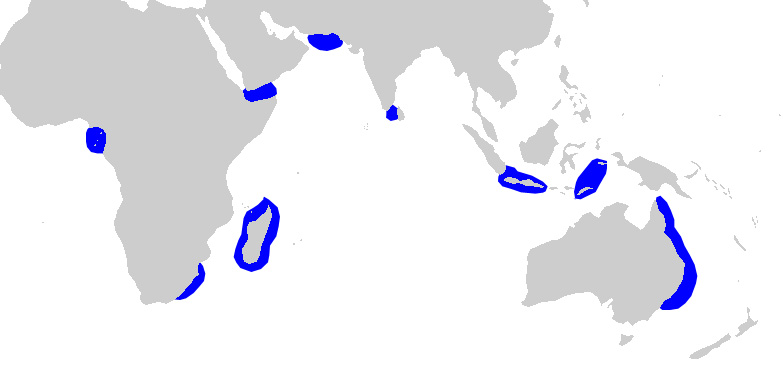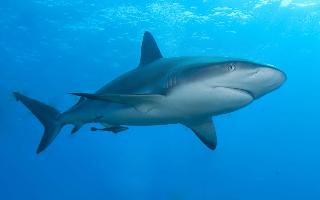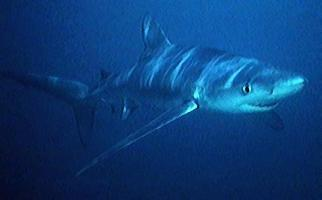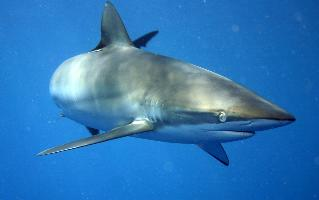
Súlyok és méretek
| Hossz | 2-tól 2,5-ig m |
|---|
Veszélyeztetettség
| Veszélyeztetett |
Állatleírás
The Pigeye Shark, scientifically known as Carcharhinus amboinensis, is a fascinating species of requiem shark, belonging to the family Carcharhinidae. This species is named for its notably large, pig-like eyes, which are one of its most distinctive features, setting it apart from other sharks. The Pigeye Shark can be found in the warm, coastal waters of the Indian and Pacific Oceans, ranging from the eastern coast of Africa to the islands of the western Pacific. It has a preference for turbid environments, often found near river mouths, estuaries, and in coastal bays, at depths up to 150 meters (490 feet).Adult Pigeye Sharks can reach lengths of up to 2.7 meters (8.9 feet), making them a relatively large species within their family. They possess a robust and streamlined body, with a broad, rounded snout and large, oval-shaped pectoral fins. The coloration of these sharks is typically a greyish-brown on the dorsal side, transitioning to a lighter, almost white, underbelly. This color scheme provides them with excellent camouflage against the sandy or muddy bottoms of their coastal habitats.
One of the most remarkable aspects of the Pigeye Shark is its diet, which is quite varied. These sharks are known to be opportunistic feeders, preying on a wide range of marine organisms. Their diet primarily consists of bony fish, cephalopods such as squids and octopuses, and crustaceans. This varied diet is facilitated by their powerful jaws and sharp, serrated teeth, which allow them to tackle a wide array of prey.
The reproductive habits of the Pigeye Shark are also noteworthy. They are viviparous, meaning they give birth to live young instead of laying eggs. The females have a yolk-sac placenta, which provides nourishment to the embryos. A litter can range from one to thirteen pups, with the gestation period lasting about a year. This mode of reproduction ensures that the young are relatively well-developed and have a higher chance of survival once they are born.
Despite their size and capabilities, Pigeye Sharks are not considered a significant threat to humans, with very few, if any, recorded incidents of aggression. However, they are often caught as bycatch in commercial fisheries, which, combined with their specific habitat preferences and slow reproductive rates, has led to concerns about their conservation status. Currently, the Pigeye Shark is listed as Near Threatened by the International Union for Conservation of Nature (IUCN), indicating that it may become threatened with extinction in the near future.
Efforts to conserve the Pigeye Shark include monitoring their populations, regulating fisheries to reduce bycatch, and protecting critical habitats. As apex predators, they play a crucial role in maintaining the health and balance of marine ecosystems, making their conservation important not just for their survival, but for the overall health of the oceans.
In summary, the Pigeye Shark is a captivating species with its large, pig-like eyes, robust body, and varied diet. Despite its formidable appearance, it remains a relatively elusive creature, shrouded in mystery due to its preference for turbid, coastal waters. As scientists continue to study this intriguing shark, it is hoped that effective conservation measures can be implemented to ensure its survival for generations to come.
Előfordulási térkép

Hasonló állatok
Új állatfotók
Top 10 állat
- Dolphin gull (Leucophaeus scoresbii)
- Japanese macaque (Macaca fuscata)
- Stone loach (Barbatula barbatula)
- Galápagos tortoise (Geochelone nigra complex)
- Russian tortoise (Testudo horsfieldii)
- Greek tortoise (Testudo graeca)
- Diana monkey (Cercopithecus diana)
- Common flying dragon (Draco volans)
- Moustached guenon (Cercopithecus cephus)
- Galápagos penguin (Spheniscus mendiculus)


